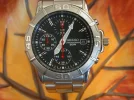Sorry, thats what they called it in highschool. Its techniqe where you actually paint in your pictures with light. May sound confusing but *can be very simple
You will need a tripod, camera with shutter speed b (you need to be able to leave the shutter open for long periods of time, flash lights, flash or high powered strobe, preferably a black back drop.
I think its best described if I tell you about 2 pictures I have done in the past.
For the fisrt picture I set up my tripod and camera and turned off all the lights. I opened the shutter and then walked over to my desk( sometimes hard to manuver in pitch black) I then took a tiny flash light and actually traced areas of the desk and various objescts on it. Anything I wanted to really stand out, I traced more. Any thing I wanted hidden I shined no light on it at all. This allows complete control of exposure for the entire photo. I then used a bigger flash light and placed it directly in front of the lamp where the bulb was, and pointed it towards that lens, and flashed it. This gives the illusion that the lamp was on, (God I hope I am not confusing you) This photo took about 20 min to complete. When I guessed* I was done, I walked over to the camera and closed the shutter. Did several areas of the room. Its amazing how much freedom this can give you.
The next picture was in a studio setting. I had a person stand infront of a black back drop. I had him hold out his hands as if he was juggling, (hands out, curled just a bit, head tilted looking up) When I felt he was in best possible posisition, I turned the lights off and opened the shutter on the camera(on a tripod). I then walked used a flashed the room with a standard camera flash. This give an intial imprint of my subject. I then walked over and used a very large flashlight and placed it in his hand, bulb facing camera lens. I flashed the flash light quickly. I did so again for the other hand and again, just above my subjects head, in the area of where he might have been looking. I also used the flash light to iluminate the area around his hands. I then close the shutter, then turn on the lights.
When I was done and developed the picture with high contrast. When all done, it gave the illusion that he was actually juggling 3 balls of light.
Lots of things can be done and you can flash over and over again, I had my subject actually pretend to be in a fight, having him shadow box feely and every few secnds told him to freeze, flashed and had him continue. When this pic was done, you saw every pused moment, ghosted on top one another, looked like an agent from the matrix dodging bullets.
Any more questions I'll be happy to answer. And if you really would like I'll look to see If I have any examples to post.














